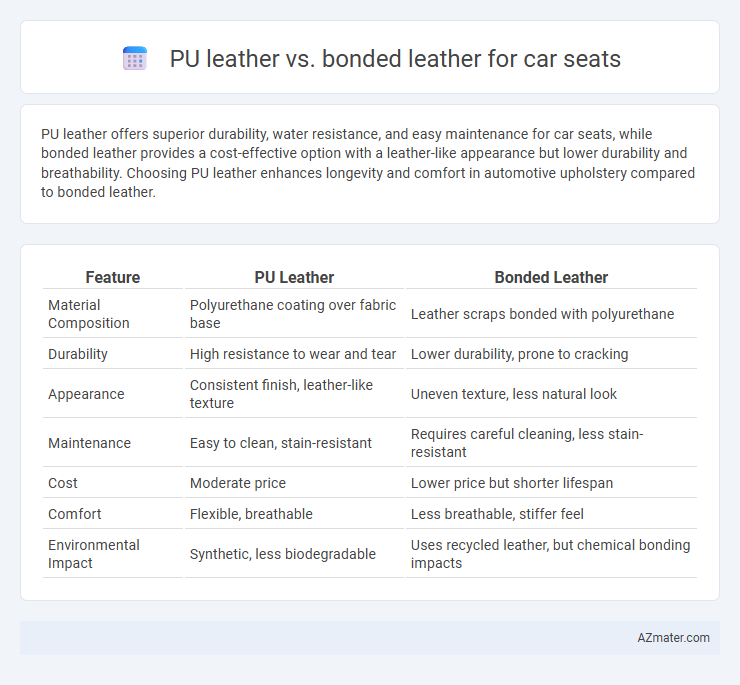PU leather offers superior durability, water resistance, and easy maintenance for car seats, while bonded leather provides a cost-effective option with a leather-like appearance but lower durability and breathability. Choosing PU leather enhances longevity and comfort in automotive upholstery compared to bonded leather.
Table of Comparison
| Feature | PU Leather | Bonded Leather |
|---|---|---|
| Material Composition | Polyurethane coating over fabric base | Leather scraps bonded with polyurethane |
| Durability | High resistance to wear and tear | Lower durability, prone to cracking |
| Appearance | Consistent finish, leather-like texture | Uneven texture, less natural look |
| Maintenance | Easy to clean, stain-resistant | Requires careful cleaning, less stain-resistant |
| Cost | Moderate price | Lower price but shorter lifespan |
| Comfort | Flexible, breathable | Less breathable, stiffer feel |
| Environmental Impact | Synthetic, less biodegradable | Uses recycled leather, but chemical bonding impacts |
Introduction: PU Leather vs Bonded Leather for Car Seats
PU leather offers a durable, water-resistant surface ideal for car seats, combining synthetic materials for enhanced longevity and easy maintenance. Bonded leather consists of leather scraps bonded with polyurethane or latex, providing a lower-cost alternative but with reduced durability and breathability. For car seats, PU leather generally outperforms bonded leather in wear resistance and comfort.
What is PU Leather?
PU leather, or polyurethane leather, is a synthetic material made by coating a base fabric with a flexible polymer, offering a leather-like appearance and texture. It is highly durable, water-resistant, and easier to maintain compared to bonded leather, making it ideal for car seats exposed to daily wear and spills. The uniform quality and breathability of PU leather also provide enhanced comfort and longevity in automotive interiors.
What is Bonded Leather?
Bonded leather for car seats is made by combining shredded genuine leather fibers with a polyurethane or latex binder, then embossing the surface to mimic the texture of natural leather. This material offers an affordable alternative with the appearance of leather but typically lacks the durability and breathability of PU leather, which is made entirely from polyurethane over a fabric backing. Bonded leather tends to wear out faster and may peel or crack under prolonged exposure to heat and friction in automotive environments.
Durability Comparison: PU Leather vs Bonded Leather
PU leather offers superior durability for car seats due to its resistance to cracking, fading, and wear over time compared to bonded leather, which tends to deteriorate faster because it's made from shredded leather fibers mixed with adhesives. The dense synthetic structure of PU leather withstands frequent friction and exposure to sunlight better, making it a longer-lasting choice in automotive interiors. Bonded leather, while more affordable, often peels and loses its texture with extended use, reducing the overall lifespan of car seat upholstery.
Comfort and Feel: Which Material Wins?
PU leather offers a smoother, more flexible surface that closely mimics genuine leather, providing superior comfort and a soft touch for car seats. Bonded leather, made from leather scraps bonded with synthetic material, tends to be stiffer and less breathable, which can reduce overall comfort during long drives. For a car seat that prioritizes comfort and a premium feel, PU leather is generally the preferred choice.
Maintenance and Cleaning Tips
PU leather car seats require regular wiping with a damp cloth and mild soap to maintain their smooth, synthetic surface and prevent cracking or peeling. Bonded leather seats need gentle cleaning with a vacuum or soft brush to remove dust, followed by using a leather cleaner specifically formulated for bonded materials to avoid damage. Both materials benefit from conditioning every few months to preserve flexibility and appearance, but avoid harsh chemicals and excessive moisture to extend seat longevity.
Cost and Value: Which Offers Better Return?
PU leather for car seats typically offers a better return on investment due to its durability and lower maintenance costs compared to bonded leather, which tends to wear out faster and requires more frequent replacement. While bonded leather is often more affordable upfront, PU leather's longer lifespan and resistance to cracking and fading make it a more cost-effective choice over time. Choosing PU leather maximizes value by balancing initial cost with longevity and overall comfort in vehicle interiors.
Eco-Friendliness and Sustainability Factors
PU leather for car seats offers greater eco-friendliness by using synthetic materials that reduce dependence on animal hides and minimize waste through more controlled manufacturing processes. Bonded leather, made from leather scraps bonded with adhesives, tends to be less sustainable due to its shorter lifespan and reliance on chemical binders that can release volatile organic compounds (VOCs). Choosing PU leather supports sustainability efforts by promoting durability and recyclability, whereas bonded leather's environmental impact is compounded by limited biodegradability and potential off-gassing.
Aesthetic Differences: Look and Color Options
PU leather offers a smooth, consistent texture with a wide variety of color options, making it ideal for customized car seat designs. Bonded leather displays a more natural, varied grain but tends to have limited color choices due to its composite nature. The uniform appearance of PU leather often provides a sleek, modern look, while bonded leather brings a more traditional, organic aesthetic to car interiors.
Which Leather is Best for Car Seats?
PU leather offers superior durability, water resistance, and a consistent texture, making it ideal for car seats that require long-lasting performance and easy maintenance. Bonded leather, composed of real leather fibers mixed with synthetic materials, tends to wear out faster, peel, and absorb stains, which reduces its suitability for high-use automotive interiors. For car seats, PU leather is the best choice due to its combination of affordability, resilience, and high-quality appearance.

Infographic: PU leather vs Bonded leather for Car seat
 azmater.com
azmater.com